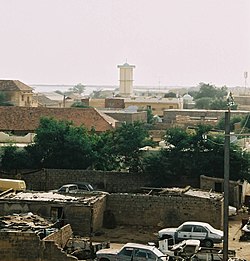Rosso
|
Rosso روصو |
|
|---|---|
| Commune and town | |
 |
|
| Location in Mauritania | |
| Coordinates: 16°30′46″N 15°48′18″W / 16.51278°N 15.80500°W | |
| Country |
|
| Region | Trarza |
| Elevation | 6 m (20 ft) |
| Population (2013 census) | |
| • Total | 51,026 |
Rosso is the major city of south-western Mauritania and capital of Trarza region. It is situated on the Senegal River at the head of year-round navigation. The town is 204 km south of the capital Nouakchott. The Arabic name is Al-Quwarib.
Rosso was once the capital of the Emirate of Trarza, a Precolonial Sahrawi dominated state in Africa.
Under French colonial rule Senegal and Mauritania were administered as a single entity. When independence came, the new frontier was drawn along the Senegal River, thus splitting the small town of Rosso in two. This article refers to Mauritanian Rosso, on the northern bank of the river.
Originally a staging-post for the gum arabic trade, Rosso has grown rapidly since independence. From a population of a mere 2 300 in 1960 it has now overtaken Kaédi to become the 3rd largest city in the country with 48 922 inhabitants (2000 census).
South-western Mauritania is predominantly a Wolof -speaking area but many members of Mauritania's other ethnic groups have moved to the town to escape the severe problems of desertification further north.
Rosso occupies a strategic position at the international ferry-crossing on the main road between Nouakchott and the Senegalese capital of Dakar. Economically the town has benefited but its fortunes are very dependent on the state of relations between the two countries. From 1990-92 the border crossing was closed, due to the Mauritania–Senegal Border War, and there have been repeated movements of refugees in both directions through the town.
Rosso has the highest annual rainfall in the country at 300mm/yr and is one of the market towns which serve the narrow strip of agricultural land stretching along the southern frontier of Mauritania. But even here the Sahara is encroaching. Major irrigation projects have been carried out on the northern bank of the Senegal River, financed by the United Arab Emirates, allowing an expansion in the production of cash crops such as mint. In 2004 however up to 80% of crops were lost as a result of the infestation of locusts which affected the whole of the western Sahel. This was followed by a severe drought. It was a bitter irony then that in August 2005 some 10,000 people were displaced by flooding.
...
Wikipedia

